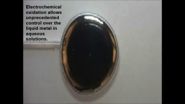(Press-News.org) VIDEO:
Liquid metals have very large surface tensions that causes them to assume a spherical shape. Researchers have shown that the deposition of a surface oxide lowers the surface tension...
Click here for more information.
Researchers from North Carolina State University have developed a technique for controlling the surface tension of liquid metals by applying very low voltages, opening the door to a new generation of reconfigurable electronic circuits, antennas and other technologies. The technique hinges on the fact that the oxide "skin" of the metal – which can be deposited or removed – acts as a surfactant, lowering the surface tension between the metal and the surrounding fluid.
The researchers used a liquid metal alloy of gallium and indium. In base, the bare alloy has a remarkably high surface tension of about 500 millinewtons (mN)/meter, which causes the metal to bead up into a spherical blob.
"But we discovered that applying a small, positive charge – less than 1 volt – causes an electrochemical reaction that creates an oxide layer on the surface of the metal, dramatically lowering the surface tension from 500 mN/meter to around 2 mN/meter," says Dr. Michael Dickey, an associate professor of chemical and biomolecular engineering at NC State and senior author of a paper describing the work. "This change allows the liquid metal to spread out like a pancake, due to gravity."
The researchers also showed that the change in surface tension is reversible. If researchers flip the polarity of the charge from positive to negative, the oxide is eliminated and high surface tension is restored. The surface tension can be tuned between these two extremes by varying the voltage in small steps. Video of the technique in action can be seen here.
"The resulting changes in surface tension are among the largest ever reported, which is remarkable considering it can be manipulated by less than one volt," Dickey says. "We can use this technique to control the movement of liquid metals, allowing us to change the shape of antennas and complete or break circuits. It could also be used in microfluidic channels, MEMS, or photonic and optical devices. Many materials form surface oxides, so the work could extend beyond the liquid metals studied here."
Dickey's lab had previously demonstrated a technique for "3-D printing" liquid metals, which used the oxide layer formed in air to help the liquid metal retain its shape – the exact opposite of what the oxide layer does to the alloy in a basic solution.
"We think the oxide's mechanical properties are different in a basic environment than they are in ambient air," Dickey says.
INFORMATION:
The paper, "Giant and Switchable Surface Activity of Liquid Metal via Surface Oxidation," will be published online in the Proceedings of the National Academy of Sciences during the week of September 15. Lead authors of the paper are Mohammad Rashed Khan and Collin Eaker, Ph.D. students at NC State. The paper was co-authored by Dr. Edmond Bowden, a professor of chemistry at NC State.
The research was supported by National Science Foundation (NSF) CAREER grant number CMMI-0954321 and the Research Triangle NSF Materials Research Science and Engineering Center on Programmable Soft Matter grant number DMR-1121107.
Researchers control surface tension to manipulate liquid metals
2014-09-15
ELSE PRESS RELEASES FROM THIS DATE:
Neuroscientists identify key role of language gene
2014-09-15
CAMBRIDGE, MA -- Neuroscientists have found that a gene mutation that arose more than half a million years ago may be key to humans' unique ability to produce and understand speech.
Researchers from MIT and several European universities have shown that the human version of a gene called Foxp2 makes it easier to transform new experiences into routine procedures. When they engineered mice to express humanized Foxp2, the mice learned to run a maze much more quickly than normal mice.
The findings suggest that Foxp2 may help humans with a key component of learning language ...
Network measures predict neuropsychological outcome after brain injury
2014-09-15
Cognitive neuroscience research has shown that certain brain regions are associated with specific cognitive abilities, such as language, naming, and decision-making.
How and where these specific abilities are integrated in the brain to support complex cognition is still under investigation. However, researchers at the University of Iowa and Washington University in St. Louis, Missouri, believe that several hub regions may be especially important for the brain to function as an integrated network.
In research published online Sept. 15 in the Early Edition of the Proceedings ...
Cells simply avoid chromosome confusion
2014-09-15
Reproductive cell division has evolved a simple, mechanical solution to avoid chromosome sorting errors, researchers report in the Sept. 11 Science Express.
This natural safeguard prevents incorrect chromosome counts and misalignments that lead to infertility, miscarriage, or congenital conditions.
"Mistakes during reproductive cell division cause these problems, but what exactly goes wrong is often not understood," said Adele Marston of the Wellcome Trust Center for Cell Biology at the University of Edinburgh in Scotland and lead author of the study. Understanding ...
NASA's TRMM satellite sees Hurricane Odile strike Baja California
2014-09-15
VIDEO:
This animation of NOAA's GOES-West satellite imagery from Sept. 13 through Sept. 15 shows Hurricane Odile's movement and landfall near Cabo San Lucas on Mexico's Baja California. TRT 0:42...
Click here for more information.
NASA's Tropical Rainfall Measuring Mission satellite known as TRMM captured data on powerful Hurricane Odile revealing heavy rainfall from powerful thunderstorms as it made landfall in Baja California. Odile tied a record for strongest hurricane to hit ...
IU study: Combining epilepsy drug, morphine can result in less pain, lower opioid doses
2014-09-15
INDIANAPOLIS -- Adding a common epilepsy drug to a morphine regimen can result in better pain control with fewer side effects. Moreover, the combination can reduce the dosage of the opioid needed to be effective, according to a team of pain researchers at Indiana University.
The result could bring significant relief to many patients with neuropathic pain, a difficult-to-treat condition often felt in the arms and legs and associated with nerve tissue damage.
"There is a huge unmet need for better treatments for neuropathic pain," said Fletcher A. White, Ph.D., the Vergil ...
'Squid skin' metamaterials project yields vivid color display
2014-09-15
The quest to create artificial "squid skin" -- camouflaging metamaterials that can "see" colors and automatically blend into the background -- is one step closer to reality, thanks to a breakthrough color-display technology unveiled this week by Rice University's Laboratory for Nanophotonics (LANP).
The new full-color display technology uses aluminum nanoparticles to create the vivid red, blue and green hues found in today's top-of-the-line LCD televisions and monitors. The technology is described in a new study that will be posted online this week in the Early Edition ...
Researchers discover new producer of crucial vitamin
2014-09-15
New research has determined that a single group of microorganisms may be responsible for much of the world's vitamin B12 production in the oceans, with implications for the global carbon cycle and climate change.
Although vitamin B12 is an essential molecule required by most life on this planet, it is only produced by a relatively small group of microorganisms because it is so large and complex. For humans, vitamin B12 plays a key role in maintaining the brain and nervous systems, as well as DNA synthesis in cells throughout the body.
Professors Andew Doxey and Josh ...
X-rays unlock a protein's SWEET side
2014-09-15
Sugar is a vital source of energy for both plants and animals alike.
Understanding just how sugar makes its way into the cell could lead to the design of better drugs for diabetes patients and an increase in the amount of fruits and vegetables farmers are able to grow. Stanford University researchers have recently uncovered one of these "pathways" into the cell by piecing together proteins slightly wider than the diameter of a strand of spider silk.
To determine the size, shape and orientation of one of the newest (and smallest) of these proteins, the sugar transporter, ...
Pitt chemical biologist finds new halogenation enzyme
2014-09-15
PITTSBURGH—Molecules containing carbon-halogen bonds are produced naturally across all kingdoms of life and constitute a large family of natural products with a broad range of biological activities. The presence of halogen substituents in many bioactive compounds has a profound influence on their molecular properties.
One of the Holy Grails in chemical science has been to find the late-stage, site-specific incorporation of a halogen atom into a complex natural product by replacing an sp³ C-H bond (one of the most inert chemical bonds known in an organic compound) with ...
Satellite sees Tropical Depression 16-E remnants scooped by Hurricane Odile
2014-09-15
At 11 p.m. EDT on Sunday, September 14, Tropical Depression 16-E was officially a remnant low pressure area. NOAA's GOES-West satellite showed the clouds associated with the remnants being drawn into the massive circulation of nearby Hurricane Odile.
At 5 a.m. on Sunday, September 14, Tropical Depression 16-E (TD 16-E) was still holding together despite being close to the circulation of Hurricane Odile. At that time, the center of tropical depression 16-E was located near latitude 14.9 north and longitude 115.3 west. That's about 655 miles (1,055 km) south-southwest ...






